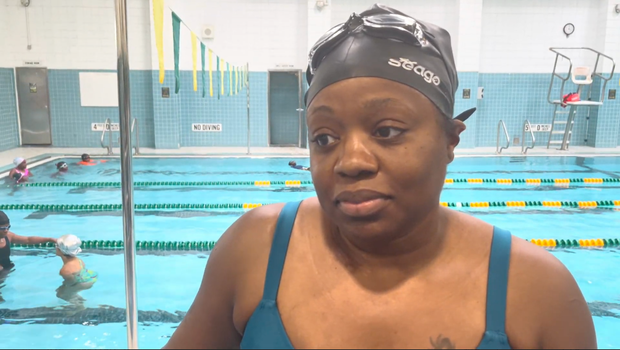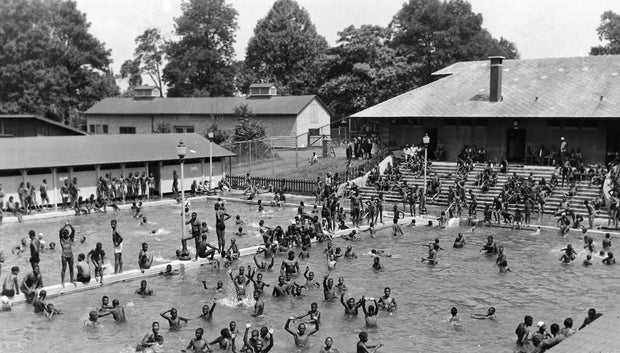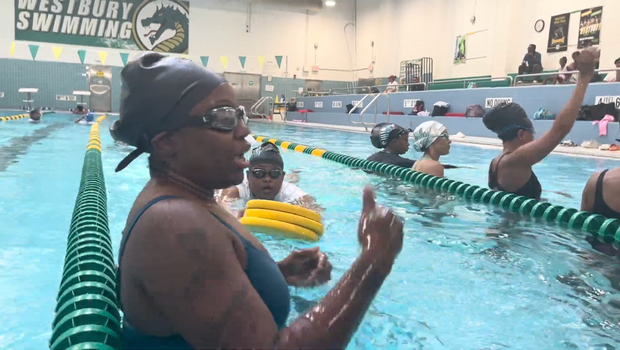At 42, Tameka Bostick decided she wanted to learn how to swim. Bostick said she tried to sign her teenager up for lessons, too, but her daughter said she wanted her mother to learn to swim first.
“‘Ma, you do it first and see how it is, and then I’ll do it,'” Bostick recalled to CBS News right before starting her beginner swim class in Westbury, New York, run by the not-for-profit organization Black People Will Swim. “I did want to learn how to swim, so I was like, ‘You know what? I’ll do it.'”
Bostick said she grew up in New York City housing projects and didn’t have much access to pools in the community, so she didn’t have a chance to learn.
Jared Ochacher CBS News
“There is a stigma Black people can’t swim,” said Bostick.
Paulana Lamonier, the founder of Black People Will Swim, started the organization in 2020 to help students like Bostick. She said she didn’t see enough Black and Brown swimmers, which meant teaching more Black people to swim in an effort to create a ripple effect of more Black swim instructors and lifeguards, she said.
Lamonier’s goal of making swimming more accessible for Black people has been rooted in a history of segregation and lack of equity in aquatic spaces.
“The numbers don’t lie,” Lamonier said. “Black and Brown people are more likely to drown than their white counterparts.”
Segregation in swimming
For decades, starting in the early 1900s, just as pools across the United States began to open to mixed-gender swimming, opportunities to access water started to close for Black Americans. In 1913, St. Louis opened its first gender-integrated swimming pool, leading to racial tensions over when and where Black swimmers could use pools. Riots began to break out at integrated swimming pools and federal mandates were imposed ordering racial segregation of pools in various cities, according to USA Swimming.
University of Montana history professor Jeff Wiltse has researched racial disparities in swimming.
During a university lecture in 2023, Wiltse said, “Racial segregation, racial exclusion, at public pools was not just a phenomenon in the South. That was a nationwide phenomenon, even though it varied a little bit and exactly how it occurred.”
Pools across the U.S. became more accessible after 1973 when the Supreme Court ruled that a swimming association can’t limit membership or refuse admission to a pool based on racial reasons.
Getty Images
Even so, research shows 64% of Black children have little to no swimming ability, according to USA Swimming. Black people under age 30 are 1.5 times more likely to drown than their White peers — with the disparities growing starker for children, the Centers for Disease Control and Prevention found. Black children ages 10-14 years are 7.6 times more likely to drown in pools than White children, the CDC says.
“Drowning happens to be one of the most prevalent sources of death among African American males,” said Dr. Samuel Myers, Jr. a professor and director at the Roy Wilkins Center for Human Relations and Social Justice at the University of Minnesota.
Myers, an economist, told CBS News he began to research racial disparities in swimming after attending his daughter’s swim meets, where he says he was often the only Black parent. He said he asked himself, “How is it possible that there are so few Black swimmers in this pool?”
Myers said he found in his research a correlation between drowning rates and Black lifeguards, saying the “drowning rates are lower” when there are “more Black lifeguards.”
Myers said, “There are policies that we can enact in order to reduce drowning.”
A determined change
Bostick was determined not to have history repeat itself when she moved out to the suburbs in Long Island from New York City. She had two daughters and vowed that her children would learn how to swim.
She said her kids are nine years apart, and her oldest daughter is a good swimmer. She said she saw the ad for Black People Will Swim on social media. There was a discount offered, and so she signed up.
Scholarships from partner organizations support new swimmers, as lessons can be cost-prohibitive for many. Outdoor Afro, one of Black People Will Swim’s partner organizations, has given over 3,000 “swimmerships” to swimmers in the Black and Brown communities through its “Making Waves” program.
Founder Rue Mapp told CBS News she heard too many stories of Black people drowning through her work in 30 states and the 60,000 people in their network, encouraging people to get into the great outdoors – and she felt compelled to act.
Jared Ochacher CBS News
“This is a public health crisis,” she said. “No child, no one in America, should have any barrier to connecting to water.”
But Mapp said in some cases, “people often don’t know where to start.”
“A door needs to just be opened,” she said. “People go on to invest in swimming, they just need beginner lessons.”
Bostick — who said she drives 40 minutes to attend her lessons — said learning to swim, breathe and use water safety skills was “very humbling.” Bostick said she went swimming on the Fourth of July, and was able to keep an eye out for those around her.
“I was able to use the skills I learned in here out there,” she said. “I felt like a superstar!”
Bostick said she’s grateful she took the time as an adult to learn to swim.
“There’s nothing to be ashamed of, I’m 42 and just now learning,” Bostick said. “And I love it! I wished I had learned when I was younger. But I’m grateful I stepped outside of my comfort zone and thankful to my daughter for making me go first.”



